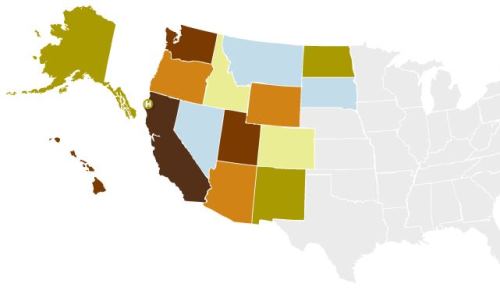Learn how the location of your college could affect your tuition costs.

When searching for a college match, it’s important to keep your financial situation in mind. Unlike the varying aspects of the college experience like academic offerings, campus life and community diversity, paying tuition is inevitable no matter where you go. In addition, the location of certain colleges will determine which tuition rate you pay. In this article, we’ll explain how in-state and out-of-state tuition work to help you figure out which schools you can afford.
Tuition Based on Your Home State
If you’ve already started researching schools, then you know that one of the biggest determining factors in tuition costs is often whether a college is located in your home state. While private schools tend to charge the same tuition for in-state and out-of-state students, public colleges and universities generally have higher tuition rates for students whose permanent address is in another state. States offer lower in-state tuition to provide affordable educational opportunities to their residents, which they hope will, in turn, lead to a well-educated electorate that will help the state economy and lead to social and cultural growth.
Reciprocity programs provide ways for students to attend an out-of-state schools without paying out-of-state tuition.
When it comes to the numbers, the difference between being in-state or out-of-state can vary widely from one school (or one state) to the next. For example, data from the U.S. Department of Education shows that in states like Arizona and Iowa, the difference between in-state and out-of-state tuition may be around $5,000 per year on average. Meanwhile, at the University of Alaska, out-of-state students pay over $10,000 more per year than in-state students. Fortunately, you can find more favorable rates in other states; the same data shows an average difference of only about $2,000 per year in states like Florida and Kentucky.
It’s not all bad news for out-of-state students, however. At some colleges, out-of-state students receive similar or even discounted rates compared to in-state students. For example, Eastern Oregon University charges the same tuition rates for all students, regardless of where they live. When searching for schools, it’s important to look closely at the numbers to see just how much of a difference there is between in-state and out-of-state tuition rates.

Photo: Trendir.com
Reciprocity Programs
While this phrase may not mean much to you now, a reciprocity program could be the ticket to affording that college you have your eye on. This option provides a way for students to attend an out-of-state school without paying out-of-state tuition.
Reciprocity programs are based on agreements made between certain states in a specific region. If your state participates in one of these agreements, you can attend school in one of the nearby approved states while paying the in-state tuition rate or a reduced out-of-state tuition rate. In addition to these regional programs, there are also some states which allow students from nearby counties in bordering states to attend school at the in-state tuition rate.
Below are the four regional reciprocity programs and their participating states. Speak with a school’s admissions office to find out more about the reciprocity programs they participate in.
• New England Board of Higher Education: Connecticut, Maine, Massachusetts, New Hampshire, Rhode Island, and Vermont.
• Midwestern Higher Education Compact: Kansas, Michigan, Minnesota, Missouri, Nebraska, and North Dakota.
• Southern Regional Education Board Academic Common Market: Alabama, Arkansas, Delaware, Florida, Georgia, Kentucky, Louisiana, Maryland, Mississippi, North Carolina, Oklahoma, South Carolina, Tennessee, Texas, Virginia, and West Virginia.
• Western Interstate Commission for Higher Education: Alaska, Arizona, California, Colorado, Hawaii, Idaho, Montana, Nevada, New Mexico, North Dakota (yes, them again), Oregon, South Dakota, Utah, Washington, and Wyoming.

Photo: Humboldt.edu
Getting In-State Tuition at Out-of-State Schools
If you have your heart set on an out-of-state school and you don’t qualify for a reciprocity program, there may be some options available to help you get the in-state tuition rates you’d prefer. The following are a few strategies you can use to pay less at an out-of-state college:
1. Become independent:
If you separate yourself from your parents’ finances, you may be eligible to become an in-state student. You’ll need to prove that you’ll be paying for your education on your own, and you’ll also have to pay taxes and register to vote in your new state. Your parents will no longer be able to claim you as a dependent on their tax returns if you choose this strategy.
2. Move as a family:
The whole family can move to a different state in order to get you that lower tuition rate. However, you’ll have to live in the state for a full year (along with paying taxes and registering to vote there) before your first semester of college to establish residency.
3. Have connections:
If you’re a member of the military (or a military family), some colleges will make an exception if you’re an out-of-state student. Other exceptions are sometimes made for teachers and children of policemen or firemen.
With any of these options, be sure to research the specific residency requirements of each state and speak directly with someone in admissions about your plans.
The difference between in-state and out-of-state tuition can be enormous or minimal depending on which school you want to attend. With every college you consider, be sure to look into all your options when it comes to getting a lower tuition rate.